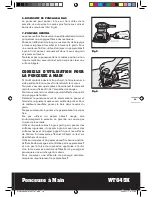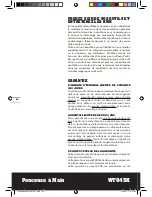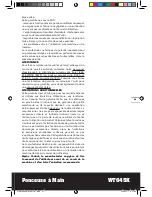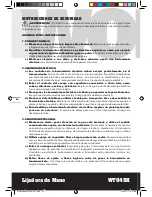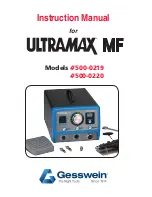
Palm Sander
WT645K
07
06
OPERATING INSTRUCTIONS
1. ON /OFF SWITCH
To start your sander, depress the protective cover over
the switch at the position marked“I”.To stop your sander,
depress the protective cover at the position marked “0”.
2. HAND GRIP AREA
You can operate your sander with one hand (See Fig 1).
3. CHANGING THE SANDING PAPER
To remove the sandpaper, lift up the clamp lever (4)
and move away from the lever lock (5) (See Fig 2). The
sandpaper clamp (3) is now loose. Repeat with the other
clamp on the opposite side of your sander.
To fit new sandpaper, insert approximately 5mm of one
end of the sandpaper under the sandpaper clamp (3) until
the paper contacts the housing wall (See Fig 2). Lift up the
clamp lever (4) and move it to the lever lock position.
Press the sandpaper around the base-plate shape as tight
as possible and fix the end under the other sandpaper
clamp (3). Check the sandpaper is square to the base-
plate, If not correct., remove and refit it again .
Always, ensure the sandpaper is tight over the base-plate
and secured underneath both locked clamps (3). This will
ensure safe and efficient sanding performance.
4. PAPER PUNCH
If using sanding paper without dust holes, use the paper
punch (7) to perforate the holes to ensure correct dust
extraction. Position the punch over the base-plate (8) with
the punch sides on the edges of the base-plate (See Fig 3).
Press the punch into the base-plate to punch holes into the
sanding paper. Then remove the punch and check all the
holes have been formed correctly.
5. DUST BAG
Always operate your sander with the dust bag fitted. For
the best performance always empty the dust bag in time.
Open the zip and empty the dust from the bag. To remove
the bag (See Fig 4). To refit the bag, firmly push the
mounting bracket into the location on the sander housing
(See Fig 5).
6. FLUSH SANDING FACILITY
Your sander can sand flush on three sides of the base-
plate which allows easy access to corners and edges of
moulding (See Fig 6).
7. ORBITAL SANDING
Your sander operates in a small circular rotation which
Fig 1
Fig 2
Fig 3
Fig 4
NA-WX645K-M-051107.indd 7
2005-11-7 9:17:32



















